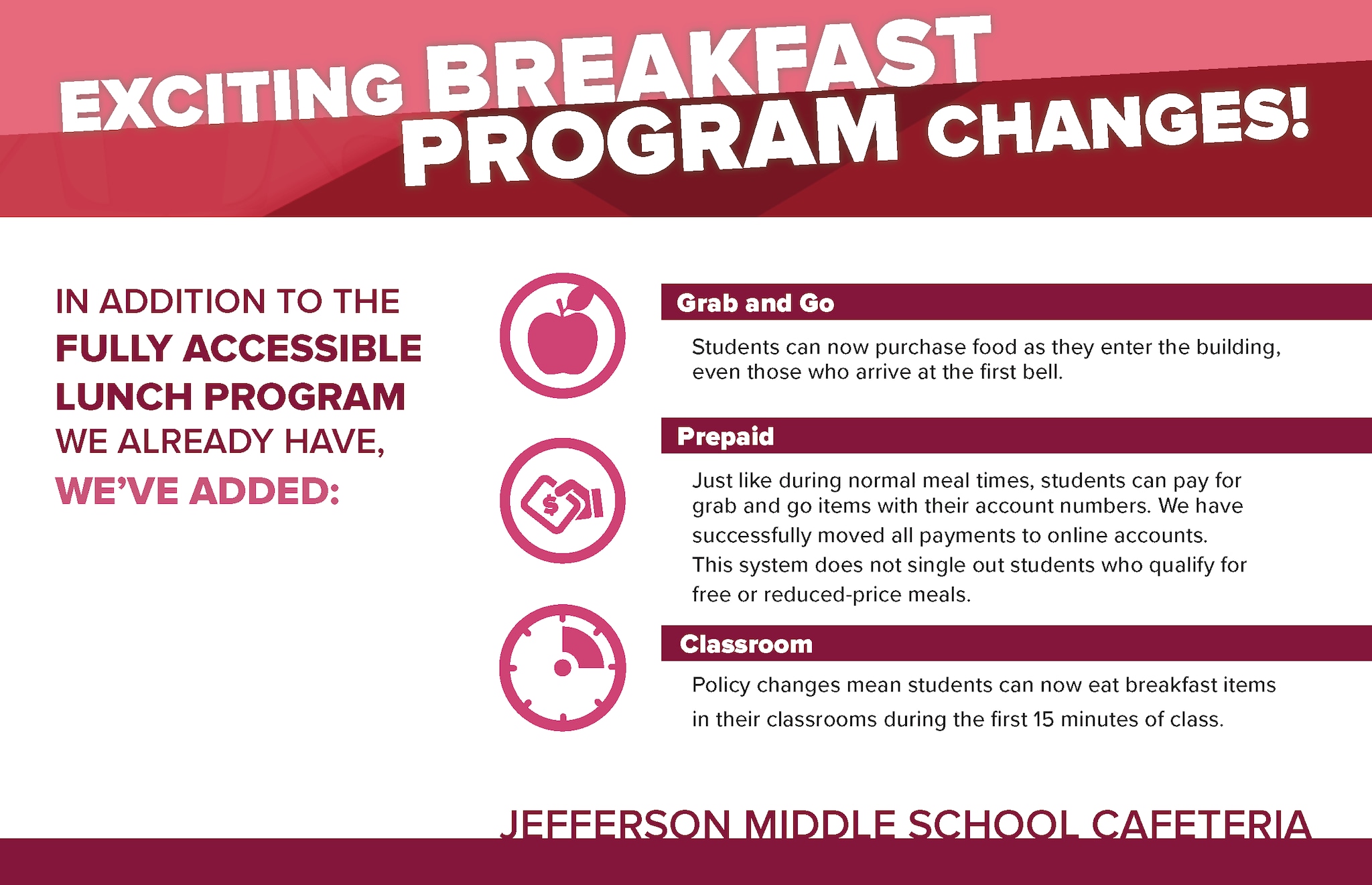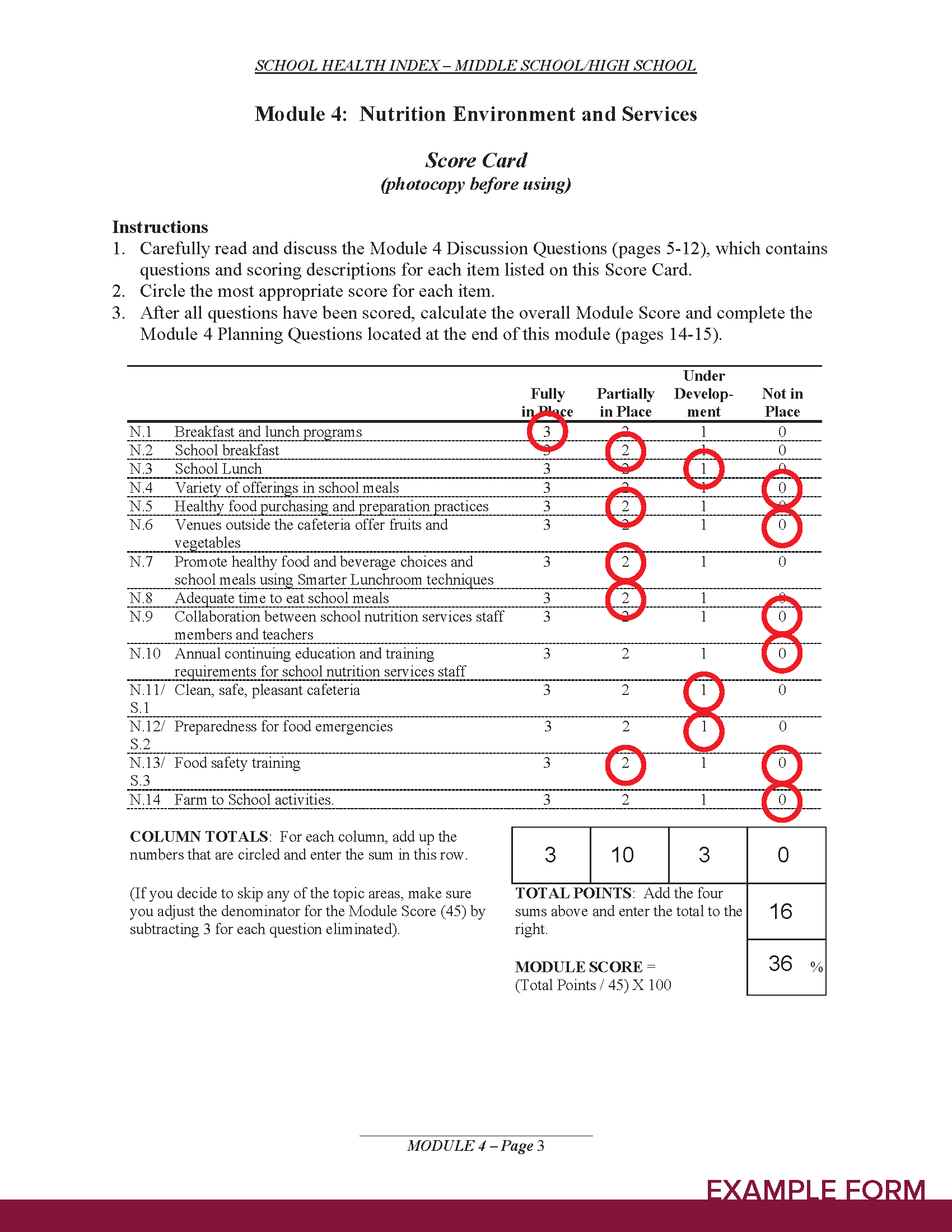CHAPTERS
- Introduction
- About the School Health Index
- School Health Index Modules
Module 1: School Health and Safety Policies and Environment
Module 3: Physical Education and Other Physical Activity Programs
Module 4: Nutrition Environment and Services
Module 5: School Health Services
Module 6: School Counseling, Psychological, and Social Services
Module 7: Social and Emotional Climate
Module 8: Physical Environment
- Using the School Health Index
Implementing the School Health Index
Step 1: Assemble the School Health Index Team
Step 2: Conduct School Health Index Introduction Meeting
Step 3: Complete Self-Assessment Process
- Conclusion
Self-Assessment Activity
Scenario
Jefferson Middle School has recently implemented changes to its breakfast program. Your School Health Team designed a flyer to send to parents, announcing the changes. The team is now in the process of evaluating the strengths and weaknesses in its Nutrition Environments and Services program to recommend additional actions for improvement in the coming year. Read the knowledge check statements and select the most appropriate responses.

Module 4 Discussion Questions
- Using the information in the flyer announcing new cafeteria services, assign the appropriate score for Jefferson Middle School on question N.1 of Module 4: "Does your school offer school meals (breakfast and lunch) programs that are fully accessible to all students?"
- Using the same flyer, assign the appropriate score for Jefferson Middle School on question N.2 of Module 4: "Does your school use strategies to maximize participation in the school breakfast program?”
- * Universal Free Breakfast
- Any program that offers breakfast to all students free of charge, regardless of their free, reduced, or paid lunch status.
The Module Score

- Your SHI team has assigned ratings to each of the items as shown in the completed score card above. Which equation shows how you would now correctly calculate the module score?
Module 4 Planning Question 1: Strengths and Weaknesses
Planning Question 1 directs you to look back on the scores assigned to each item to identify areas of strength and weakness. In general, questions that were scored as 3s or 2s are considered strengths, and those scored as 1s or 0s are considered weaknesses.
According to the Module 4: Nutrition Environment and Services Score Card:
- Is your school breakfast (N.2) considered an area of strength or weakness?
- Are your Farm to School activities (N.14) considered an area of strength or weakness?
Module 4 Planning Question 2: Recommended Actions for Weaknesses
Planning Question 2 asks you to list recommended actions for each of the areas of weakness identified.
- Select which item your team could include on its list of recommendations related to Farm to School activities (N.14).
Module 4 Planning Question 3: Priority Actions
Planning Question 3 helps prioritize the recommended actions for areas of weakness identified in Planning Question 2. The team uses a dimensions scale to assign a rating of 1 through 5 for each recommended action. In this example, recommended actions have been identified and rated for Farm to School Activities (N.14).
| Module 4 Actions | Importance | Cost | Time | Commitment | Feasibility | Total Points | Top Priority Action? |
|---|---|---|---|---|---|---|---|
| Feature local farmers/producers in school career day activities | 5 | 5 | 5 | 5 | 5 | 25 | |
| Start a school fruit and vegetable garden | 5 | 4 | 2 | 4 | 2 | 17 | |
| Incorporate local produce into the school meal program | 5 | 2 | 3 | 4 | 3 | 17 | |
| Host a field trip to a local farm | 3 | 5 | 4 | 2 | 4 | 18 |
- Based on the ratings in the table, which recommended activity should be Jefferson Middle School’s top priority for addressing Farm to School Activities?



 will appear periodically in the corner of the video to let you know that more information is available in this Go Further section. You can access the information by clicking on questions or resource titles.
will appear periodically in the corner of the video to let you know that more information is available in this Go Further section. You can access the information by clicking on questions or resource titles.